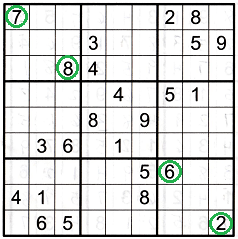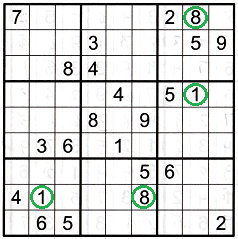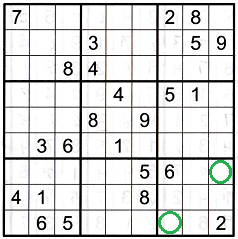Pattern: Opposite Pattern
<< Return to patterns page
Next pattern: gate pattern >>
Introduction
The opposite pattern can help find twins. Once twins are found the opposite pattern turns into a plus pattern.
Details
The opposite pattern is seen when two numbers occupy opposite corners in a box. See figure 1 below for an example.

Figure 1
Notice box 1 and box 9. They only have two numbers in each box (circled). The two numbers in these two boxes are in opposite corners. This is the opposite pattern.
Finding Twins
When you see this pattern you can look for twins by scanning the middle column that goes through the box and the middle row that goes through the box. If you find two numbers that are in both the row and the column, and the two numbers are not already in the box, you have found twins. See figure 2 below for an example of this.

Figure 2
Two numbers, 1 and 8, are in both the row and the column that go through the middle of box 9. Since there is not a 1 or an 8 already in box 9 the 1 and 8 are twins in box 9. They can only go in the two corner cells that don't already have numbers in them.
It doesn't matter whether you can solve the 1 and 8 in box 9 or not. We know they can only go in the two empty corner cells shown in figure 3 below.

Figure 3
Once twins are found the pattern changes from the opposite pattern to a plus pattern. If the twins can't be solved it is a hidden plus pattern, meaning that you can view the box as having a plus pattern even though the twins haven't been filled in. This is because no other numbers can go into the empty corner cells but the two twin values.
Example: Constraining the 4 in box 9
Take one more look at figure 3 above. Row 8 has a 4 in it (in r8c1). That 4 constrains the 4 in box 9 to column 8. Even though we couldn't solve the 18 twins in box 9 we know the 4 cannot go in column 7 or 9. This is how you use the plus pattern that came out of the opposite pattern with twins.
Next pattern: gate pattern >>
<< Return to patterns page
If Sudoku Primer and the YouTube channel have helped you, consider donating a little

Thanks in advance for your support!
More About Sudoku
Sudoku - the puzzle that addicts
